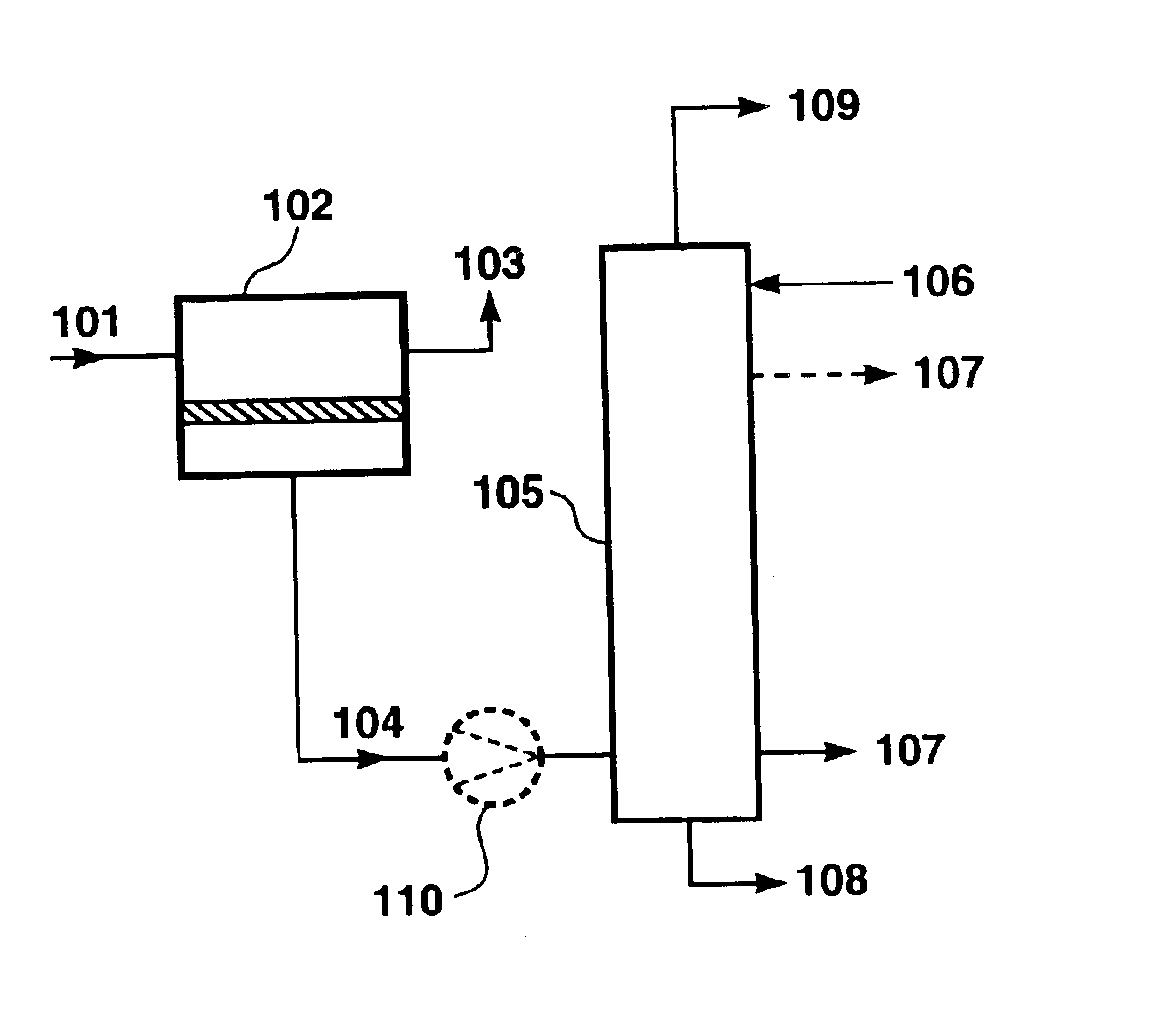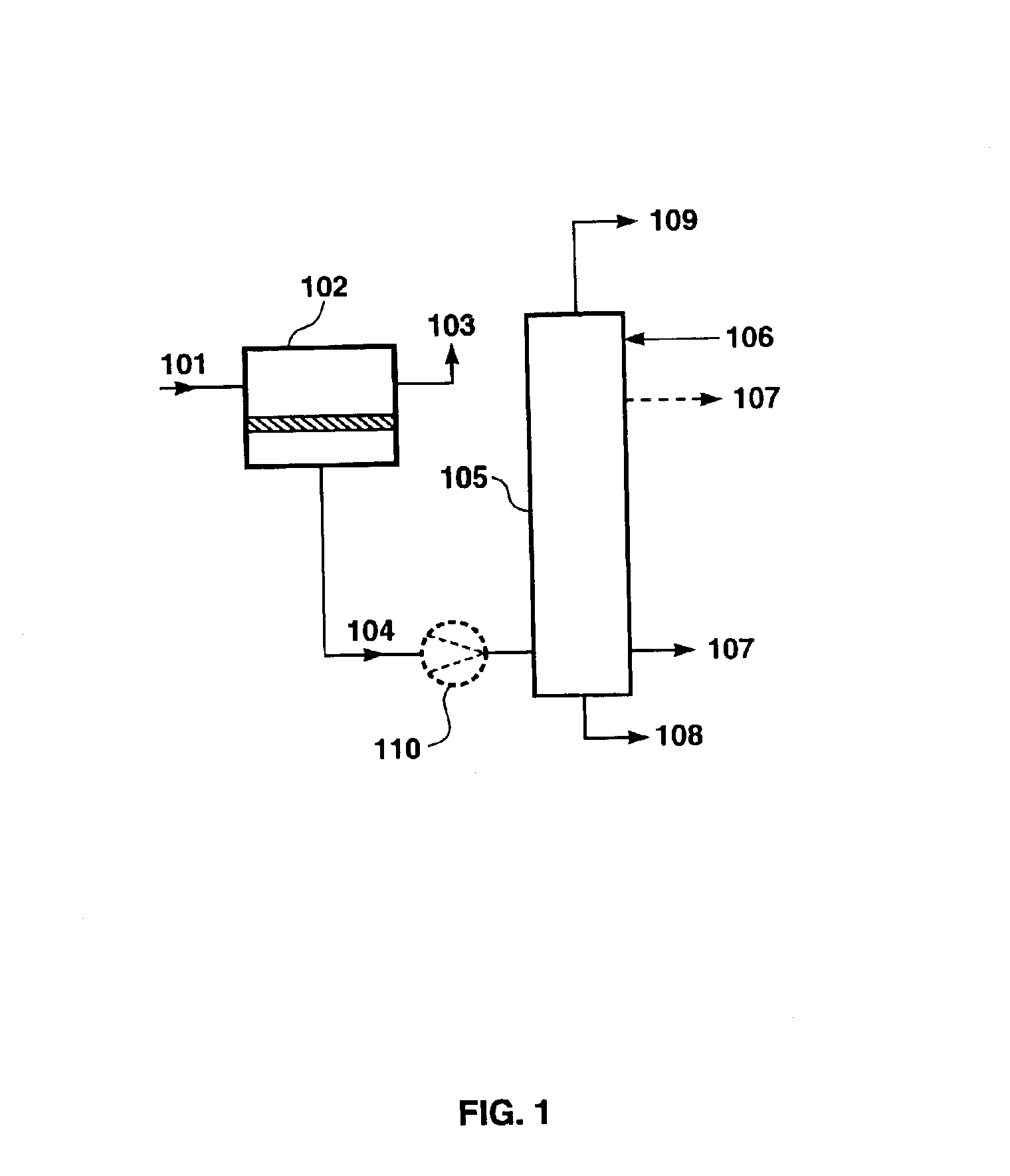Separation of organic mixtures using gas separation or pervaporation and dephlegmation
a technology of organic mixture and gas separation, which is applied in the direction of separation process, organic chemistry, dispersed particle separation, etc., can solve the problems of inability to achieve the similar organic compounds, and inability to achieve separation of hydrophilic organics, etc., to achieve the effect of improving separation, low cost and high pressur
- Summary
- Abstract
- Description
- Claims
- Application Information
AI Technical Summary
Benefits of technology
Problems solved by technology
Method used
Image
Examples
example 1
Membrane and Module Preparation
[0192]Composite membranes were prepared by standard casting and coating techniques. Asymmetric, microporous poly(etherimide) [PEI] support membranes were prepared, and the resulting membranes were coated with the following:[0193]A polyamide selective layer.[0194]A polydimethylsiloxane (PDMS) sealing / gutter layer followed by a polyamide selective layer.[0195]A polyamide-polyether block copolymer (Pebax® 4011, Atochem, Inc.) selective layer followed by a cellulose acetate sealing layer.[0196]A 40% tetrafluoroethylene / 60% 2,2,4-trifluoro-5-trifluorometoxy-1,3-dioxole (Hyflon® AD60, Ausimont, Italy) copolymer selective layer on a gutter layer.[0197]A polyperfluoro (alkenyl vinyl ether) [Cytop®, Asahi Glass, Japan] selective layer, followed by a PDMS sealing layer.[0198]A polyimide selective layer.
[0199]In addition, microporous poly(vinylidene fluoride) [PVDF] support membranes were prepared, and the resulting membranes were coated with the following:[0200]...
example 2
Pervaporation Properties
[0204]Both membrane stamps and spiral-wound membrane modules with the polyamide selective layer were tested in a pervaporation test system with an ethanol / methyl ethyl ketone (MEK) solution. A small pump was used to circulate the solution through the test module. A vacuum pump was used on the permeate side of the membrane. During the tests, feed and permeate samples were withdrawn for analysis by gas chromatography (GC) or high-pressure liquid chromatography (HPLC). The ethanol concentrations were varied from 8 to 28 wt %, the temperature was varied from 25 to 55° C., and the permeate pressure was varied from 3 to 17 mmHg. Over this concentration range, ethanol and MEK form a series of azeotropes or near azeotropes.
[0205]The fluxes were measured, and the selectivities and pervaporation separation factors were calculated. Representative results for polyamide films, composite membrane stamps and spiral-wound modules are shown in Table 1.
[0206]
TABLE 1FeedPermeat...
example 3
Pervaporation Properties
[0211]Both membrane stamps and spiral-wound membrane modules with the Pebax® 4011 selective layer were tested as in Example 2 with a toluene / methyl cyclohexane solution. The mixture is a close-boiling mixture that does not form an azeotrope. The toluene concentrations were varied from 43 to 58 wt %, the temperature was varied from 30 to 60° C., and the permeate pressure was varied from 5 to 10 mmHg. The fluxes were measured, and the selectivities and pervaporation separation factors were calculated.
[0212]Representative results for membrane stamps and spiral-wound modules are shown in Table 2.
[0213]
TABLE 2FeedPermeateFeedPermeateconc.conc.Membraneβpervapαmembranetemp.pressure(wt % (wt % flux(Tol. / (Tol. / (° C.)(mmHg)toluene)toluene)(kg / m2 · h)MeCH)MeCH)1. Polyetherimide / Pebax ® 4011 / cellulose acetate stamps30643850.37.41460544821.35.992. Polyetherimide / Pebax ® 4011 / celluloseacetate membrane modules301058830.23.59
[0214]The data indicate that the membrane is about...
PUM
| Property | Measurement | Unit |
|---|---|---|
| Temperature | aaaaa | aaaaa |
| Temperature | aaaaa | aaaaa |
| Temperature | aaaaa | aaaaa |
Abstract
Description
Claims
Application Information
 Login to View More
Login to View More - R&D
- Intellectual Property
- Life Sciences
- Materials
- Tech Scout
- Unparalleled Data Quality
- Higher Quality Content
- 60% Fewer Hallucinations
Browse by: Latest US Patents, China's latest patents, Technical Efficacy Thesaurus, Application Domain, Technology Topic, Popular Technical Reports.
© 2025 PatSnap. All rights reserved.Legal|Privacy policy|Modern Slavery Act Transparency Statement|Sitemap|About US| Contact US: help@patsnap.com



